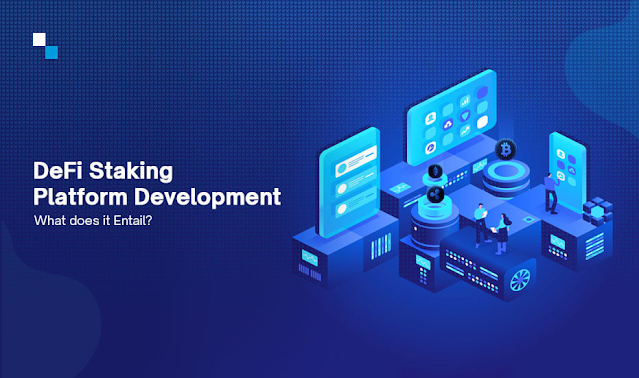How does a DeFi Staking Platform Work?
DeFi staking quickly became a popular practice in Decentralized Finance (DeFi) as it enabled crypto holders to generate passive income. Apart from this, there are two more reasons that are fuelling the growth of DeFi staking platform development:
- Proof-of-work is not an energy-friendly and sustainable consensus mechanism for blockchain. As a result, the existing blockchains like Ethereum are moving to Proof-of-Stake consensus creating a demand for staking coins.
- The number of Decentralized Finance wallets on Ethereum has crossed 3,00,000 and more crypto holders are finding it easy to stake their assets.
Basics of Crypto Staking
HODL or holding crypto is a foundational concept in crypto. DeFi staking provides crypto holders an opportunity to earn passive income for the crypto assets that lie idle in their wallets. The DeFi staking development company can design the platform in such a way that the stakers can earn up to 20% annual yield per year. But what does staking actually enable.
The purest form of staking means the stakers lock a minimum amount of their crypto assets on a platform to become a validator in a PoS blockchain. A validator is one the most crucial parts of a proof-of-stake blockchain where s/he validates a transaction and because he has a big part of their crypto assets staked in the network, s/he performs their duties diligently. Sometimes the validators do not have enough crypto assets to stake and that is when they use staking platforms to involve delegators to stake their assets and earn staking rewards as passive income.
A little deviation of pure staking is yield farming and liquidity mining. Let us take a look at them too:
- Yield Farming
Yield farming is the process in which a decentralized finance protocol is used to maximize passive income returns. The users of the protocol can lend or borrow crypto on it and for providing liquidity, they can make passive income.
Yield farmers increase their yield by employing different tactics by which they can optimize their gains.
- Liquidity Mining
DeFi protocols also support the lending and borrowing of crypto assets. In the case of a yield farm, the staker can move their crypto assets from one yield farm to another to maximize their passive income returns. The farms are a pair of two crypto-assets e.g ETH/BNB. The yield farmer will be required to pool in both ETH and BNB in a 50:50 ratio. From this pool, the DeFi blockchain development company can design a lending pool. The interest earned by lending is earned by the stakers as an annual yield.
The entire DeFi staking ecosystem comprises three participants :
- Stakers – Those who stake their assets
- Staking platforms – The platforms where assets are staked
- Protocols/Blockchains – The protocols to which the staked tokens belong to
Before we deep dive into the features of a DeFi staking platform let’s first understand the two variations of staking.
Benefits for Stakers:
- Instead of letting their crypto assets be idle, the stakers earn passive income by staking
- Staking rewards can go as high as 20% which is a pretty high yield.
- DeFi staking platforms make staking pretty simple.
- DeFi staking is managed using smart contracts which makes it secure.
Benefits for Staking Platforms:
- The DeFi staking platform enjoys increased liquidity for lending and other services
- The platform earns revenue from stakers, protocols, networks, and DeFi lending service users
Benefits for Protocols & Blockchain Networks:
- Staking ensures the security of the blockchain network
- DeFi staking helps maintain liquidity
- It also locks a certain amount of circulating supply of the tokens and leads to price pumps.
Features of a DeFi Staking Platform
- User On-boarding
Creating a user-friendly onboarding platform is very important for DeFi staking. The process begins with registering and purchase of crypto assets. A DeFi staking development company can add fiat on-ramp and multiple payment options to purchase crypto assets.
The user onboarding could involve going through KYC or not.
- Choose the assets and lock-in periods
Most of the DeFi staking platform development makes the mistake of offering only a limited selection of coins to stake. They must offer a range of coin staking, different lock-in periods, or even no lock-in periods to drive more users to the platform. The users must easily be able to choose different coins and lock-in periods.
- Rewards Calculator
The most important thing on a DeFi staking platform is a reward calculator. Even before a user stakes their coins, he can feed in parameters like which assets will he stake, the lock-in period, and the reward pay-out frequency to check how many staking rewards will he receive.
- Pay-out type and reinvestment
The platform can also be designed to allow stakers to choose whether they want the staking reward as native tokens of the staking platform or in the form of the staked token only. Also, the staker can choose to auto-reinvest their staking rewards instead of cashing them out.
- Advanced options
Some of the advanced features could be reports of gains graphs or protocol metrics, portfolio management, trading, referral benefits, and access to all the history of transactions.
Wrapping it up
In short, DeFi staking platform development must ensure there is no friction for the stakers who are looking for passive income opportunities.
At Antier Solutions, our development experts bring years of blockchain development experience to platform development. We develop and deliver world-class DeFi staking platforms fortified with market-leading features to help you gain an essential competitive edge.
Connect with our subject matter experts to share your needs for DeFi staking platform development.

.png)


Comments
Post a Comment